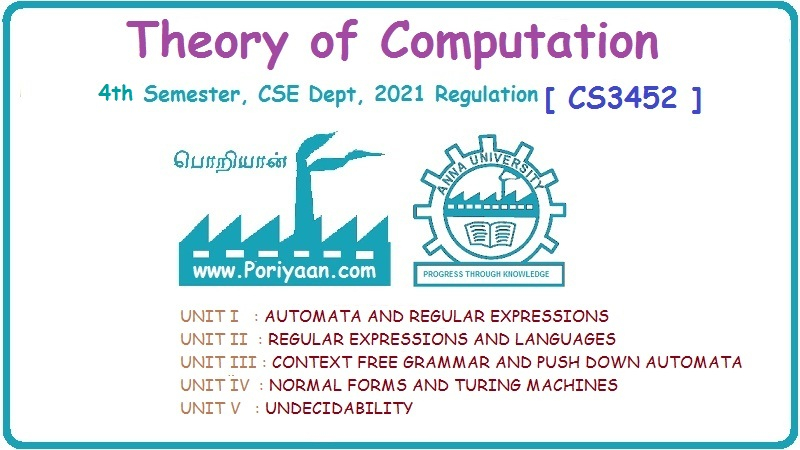Theory of Computation: Unit I: Automata and Regular Expressions
Equivalence of NFA and DFA
Automata and Regular Expressions - Theory of Computation
NFA can be converted to equivalent DFA. Let L be a set accepted by non-deterministic finite automation. Then there exists a deterministic finite automation that accepts L.
Equivalence
of NFA and DFA
AU: May-05,12,13,14,16,18,
Dec.-04,06,14,15,16,19, Marks 13
NFA
can be converted to equivalent DFA. Following theorem illustrates this concept.
Theorem:
Let L be a set accepted by non-deterministic finite automation. Then there
exists a deterministic finite automation that accepts L.
OR
Prove
that "A language L is accepted by some DFA if and only if L is accepted by
some NFA". AU: Dec.-15, Marks 10, AU: May-05, Dec.-14, Marks 10
Proof :Let
M
= (Q, Σ, δ, q0, F) be an NFA for language L. Then define DFA M' such
that,
M'
= (Q', Σ`, δ', q0`, F')
The
states of M' are all the subset of M'. The Q'=2Q.
F'
be the set of all the final states in M.
The
elements in Q' will be denoted by [q1, q2, q3,
... qi] and the elements in Q are denoted by {q0, q1,
q2, … }The [q1, q2, ... qi] will be
assumed as one state in Q' if in the NFA q0 is a initial state it is
denoted in DFA as q0` = [q0]. We define,
δ'
([q1, q2, q3, … qi], a) = [P1,
P2, P3, ... Pj]
if
and only if,
8({q1,
q2 ,q3, ....qi}, a) = {P1, P2,
P3, …. Pj}
This
means that whenever in NFA, at the current states (q1, q2,
q3, ...qi} if we get input a and it goes to the next states [P1, P2, ...
Pj} then while constructing DFA for it the current state is assumed
to be [q1, q2, q3, … qi, a]. At this state, the input is a and the next is assumed to be [P1,
P2, ... Pj]. On applying δ function on each of the states
q1, q2, q3, ...qi the new states
may be any of the states from [P1, P2, ... Pj].
The theorem can be proved with the induction method by assuming length of input
string x
δ'
(q0, x) = [q1, q2, ... qi].
if
and only if,
δ
(q0, x) = {q1, q2, q3, ... qi}
Basis:
If length of input string is 0
i.e.
|x| = 0, that means x is ε then q0` = [q0]
Induction:
If we assume that the hypothesis is true for the input string of length m or
less than m. Then if x a is a string
of length m+1. Then the function δ' could be written as,
δ'
(q0, xa) = δ' (δ' (q0,
x), a)
δ'
(q0, x) = [P1,
P2, … Pj]
if
and only if,
δ
(q0, x) = {P1,
P2, P3, ... Pj}
By
definition of δ'
δ'
([P1, P2, … Pj], a) = [r1, r2,
.... rk]
if
and only if,
δ
({P1, P2, … Pj} a) = {r1, r2,
... rk}
Thus
δ'
(q0, x a) = [r1,
r2, .... rk]
if
and only if
δ
(q0, x a) = {r1,
r2, ... rk}
is
shown by inductive hypothesis.
Thus
L (M) = L (M')
With
the help of this theorem, let us try to solve few examples.
Conversion from NFA to DFA
We
will discuss the method of converting NFA to its equivalent DFA.
Let,
M = (Q, Σ, δ, q0, F) is a NFA which accepts the language L(M). There
should be equivalent DFA denoted by M' = (Q', Σ`, δ', q0`, F') such
that L(M) = L(M').
The
conversion method will follow following steps -
1)
The start state of NFA M will be the start for DFA M'. Hence add q0
of NFA (start state) to Q'. Then find the transitions from this start state.
2)
For each state [q1, q2, q3, ... qi]
in Q' the transitions for each input symbol Σ can be obtained as,
i)
δ' ([q1,q2 ...qi], a) = δ (q1, a) U
δ (q2, a) U .........(qi, a)
=
[q1, q2, …. qk ] may be some state.
ii)
Add the state [q1, q2, .... qk] to DFA if it
is not already added in Q'.
iii)
Then find the transitions for every input symbol from Σ for state [q1,
q2, ....,qk ]. If we get some state [q1, q2,
... qn ] which is not in Q' of DFA then add this state to Q`.
iv)
If there is no new state generating then stop the process after finding all the
transitions.
3)
For the state [q1, q2, …. qn] ϵ Q' of DFA if
any one state qi is a final state of NFA then [q1, q2,......qn
] becomes a final state. Thus the set of all the final states ϵ F' of DFA.
Example 1.10.1
Determine the DFA from a given NFA.
M = ((q0, q1),
(a, b), δ, q0, {q1}) with the state table diagram for δ
given below.

AU Dec.-16, Marks 10, May-18, Marks
13
Solution:
Let the DFA M'= (Q', Σ, δ ', q0, F')
Now,
the δ' function will be computed as follows -
As
δ (q0, 0) = {q0, q1} δ` ([q0], 0) =
[q0, q1]
As
in NFA the initial state is q0, the DFA will also contain the
initial state [q0].
Let
us draw the transition table for δ function for a given NFA.
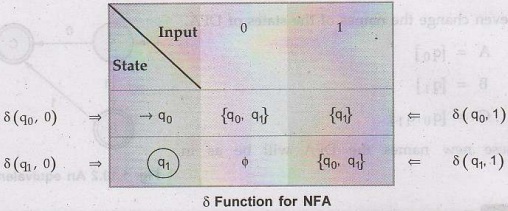
From
the transition table we can compute that there are [q0], [q1],
[q0, q1] states for its equivalent DFA. We need to compute
the transition from state [q0, q1].
δ
({q0, q1},0) = δ (q0, 0) U δ (q1,
0)
=
{q0, q1} U ϕ
=
{q0, q1}
So,
δ' ([q0, q1], 0) = [q0, q1]
Similarly,
δ'
({q0, q1}, 1) = δ (q0,1) U δ (q1,1)
=
{q1} U {q0, q1}
=
{q0, q1}
So,
δ' ([q0, q1], 1) = [q0, q1]
As
in the given NFA q1 is a final state, then in DFA wherever q1
exists that state becomes a final state. Hence in the DFA final states are [q1]
and [q0, q1]. Therefore set of final states F = {[q1],
[q0, q1]}

We
can even change the names of the states of DFA.
A
= [q0]
B
= [q1]
C=
[q0, q1]
With
these new names the DFA will be as in Fig. 1.10.2.
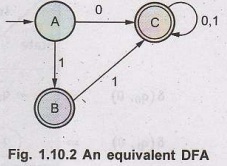
Example 1.10.2
Construct DFA equivalent to the NFA
M = ((p, q, r), (0, 1), δ, p {q,
s}) Where & is defined in the following table.
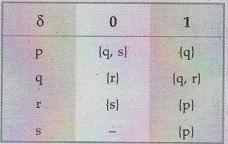
AU: Dec.-04, Marks 8
Solution:
To construct DFA,
δ
{p, 0} = {q, s} new state generated
δ
{p, 1} = {q}
δ
{q, 0} = {r}
δ
{q, 1} = {q, r} new state
δ
{r, 0} = {s}
δ
(r, 1) = {p}
δ
(s, 0} = -
δ
{s, 1} = {p}
δ
{{q, s}, 0} = {r}
δ
{{q, s}, 1} = {p, q, r} new state
8
{{q, r), 0} = {r, s} new state
δ
{{q, r}, 1} = {p, q, r}
δ
{{p, q, r}, 0} = {q, r, s} new state
δ
{{p, q, r}, 1} = {p, q, r}
δ
{{r, s), 0} = {s}
δ
{{r, s), 1} = {p}
δ
{{q, r, s}), 0} = {r, s}
δ
{{q, r, s), 1} = {p, q, r}
The
transition table is as shown below.
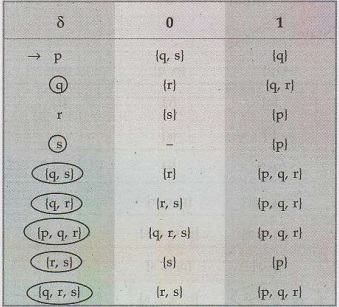
Example 1.10.3
Construct DFA equivalent to the given
NFA.

AU: Dec.-06, Marks 8, Dec.-19,
Marks 13
Solution:
The NFA M = {{p, q, r, s}, {0, 1}, δ (p), {s}}
The
equivalent DFA will be constructed.
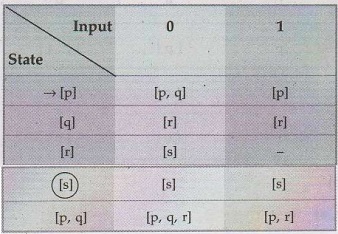
Continuing
with the generated new states.
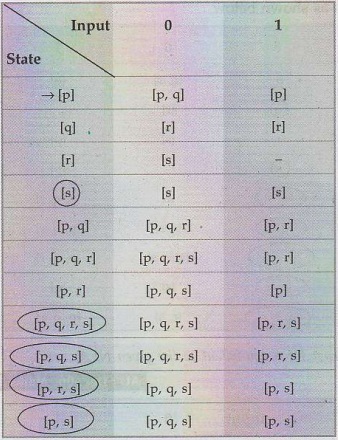
The
final state F' = { [s], [p, q, r, s], [p, q, s], [p, r, s], [p, s] }
The
transition graph shows two disconnected parts. But part I will be accepted as
final DFA because it consists of start state and final states, in part II there
is no start state. Refer Fig. 1.10.3 (See Fig. 1.10.3 on next page):
Example 1.10.4
Convert the following NFA to a DFA . AU:
May-13, Marks 10
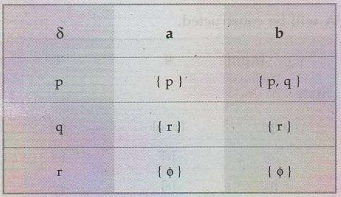
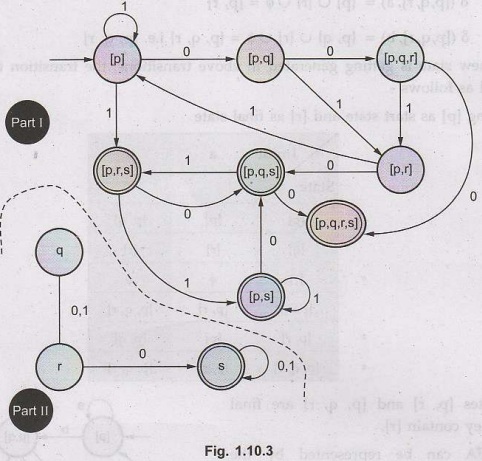
Solution:
We will apply δ transitions on each state for each input.
δ
([p], a) = [p]
δ
([p], b) = {p, q} = [p, q] → new state
δ
([q], a) = [r]
δ
([q], b) = [r]
δ
([r], a) = ϕ
δ
([r], b) = ϕ
The
8 transition on newly generated states
δ
([p, q], a) = {p, r} = [p, r] → new state
δ
([p, q], b) = {p, q, r) = [p, q, r] → new state
δ
([p, r], a) = {p} U ϕ = [p]
δ
([p, r], b) = {p, q} U i.e. [p, q]
δ
([p, q, r], a) = {p} U {r} U ϕ = [p, r]
δ
([p, q, r], b) = {p, q} U {r} U ϕ = {p, q, r} i.e. [p, q, r]
As
no new state is getting generated in above transitions, the transition table
can be constructed as follows -
Assuming
[p] as start state and [r] as final state
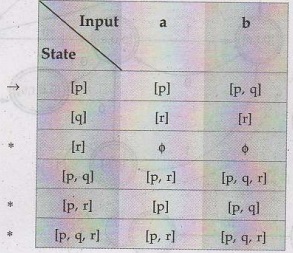
The
states [p, r] and [p, q, r] are final states as they contain [r].
The
DFA can be represented by the transition diagarm as shown -
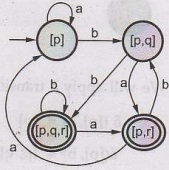
The
states [q] and [r] are eliminated as they are dead states.
Example 1.10.5
Construct a DFA accepting binary strings
such that the third symbol from the right end is 1. AU May-12, Marks 10
Solution:
The strings in such a language are -

The
NFA will be,

The
transition table can be –
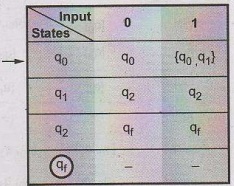
We will obtain the δ transitions on each input and state.
δ
(q0, 0) = [q0]
δ
(q0, 1) = [q0, q1] i.e. [q0, q1] → New
state
δ
(q1, 0) = [q2],
δ (q1, 1) = [q2]
δ
(q2, 0) = [qf],
δ (q2, 1) = [qf]
δ
([q0, q1], 0) = {q0, q2}, = [q0,
q2] i.e. New state
δ
([q0, q1], 1) = {q0, q1, q2}
= [q0, q1, q2] → New state
δ
([q0, q2], 0) = {q0, qF} = {q0,
qf} → New state
δ
([q0, q2], 1) = {q0, q1, 9f}
= [q0, q1, qf] → New state
δ
([q0, q1, q2], 0) = {q0, q2,
qf} → New state
δ
([q0, q1, q2], 1) = {q0, q1,
q2, qf } → New state
δ
([q0, qf], 0) = [q0]
δ
([q0, qf], 1) = [q0, q1]
δ
([q0, q1, qf], 0) = [q0, q2]
δ
([q0, q1, qf], 1) = [q0, q1,
q2]
δ
([q0, q2, qf], 0) = [q0, qf]
δ
([q0, q2, qf], 1) = [q0, q1,
qf]
δ
([q0, q1, q2, qf], 0) = [q0,
q2, qf]
δ
([q0, q1, q2, qf], 1) = [q0,
q1, q2, 9f]
The
transition table for above computation is as given below -
The
states q1, q2 and qf are not reachable states.
Hence they can be eliminated.
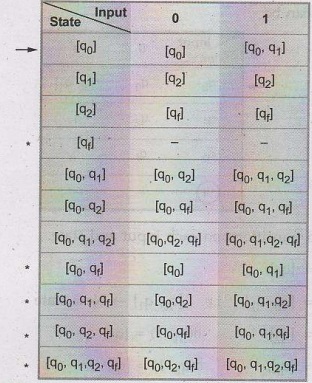
Example 1.10.6
Construct a non-deterministic finite
automaton accepting the set of strings over {a,b} ending in aba. Use it to construct
a DFA accepting the same set of strings.
AU: May-14, Marks 10
Solution:
NFA for accepting the strings ending with aba
is,

The
transition table will be
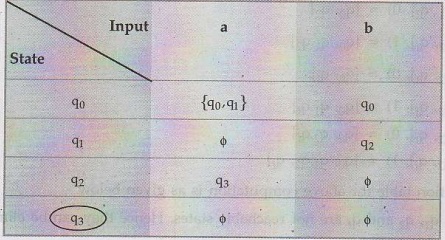
We
will obtain 8 transitions for each input on each state.
δ
(q0, a) = {q0, q1} = [q0, q1]
new state.
δ (q0, b) = {q0}
δ
(q1, a) = ϕ
δ
(q1, b) = {q2}
δ
(q2, a) = {q3}
δ
(q2, b) = ϕ
δ
(q3, a) = ϕ
δ
(q3, b) = ϕ
The
δ transitions on newly generated states is
δ
([q0, q1], a) = {q0, q1} i.e. [q0,
q1]
δ
([q0, q1], b) = {q0, q2} = [q0,
q2] new state
δ
([q0, q2], a) = {q0, q1, q3}
= [q0, q1, q3] new state
δ
([q0, q2], b) = {q0}
δ
([q0, q1, q3], a) = [q0, q1]
δ
([q0, q1, q3], b) = [q0, q2]
As
no new state is getting generated. We will build transition table is as follows
-

The
DFA will be as shown in Fig. 1.10.5
The
states q1, q2 and q3 are non-reachable. Hence
they will be eliminated.
Example 1.10.7
Construct a DFA equivalent to the NFA. M=({a, b, c, d}, {0,1} δ, a {b, d}) where
δ is a defined as AU Dec.-14, Marks 6
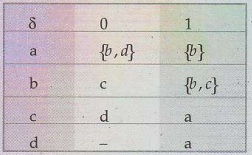
Solution: Refer
similar example 1.10.2 by assuming p = a, q=b, r = c and s = d.
Example 1.10.8
Construct NFA that accepts all string that end in 01. Give its transition table
and extended transition function for the input string 00101. Also construct a
DFA for the above NFA using subset construction method. AU May-16, Marks 10
Solution:
The NFA will be designed using
r.e.
= (0+1)* 01

The
transition table will be as follows:
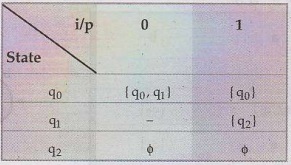
Refer
example 1.10.6 for conversion of NFA to DFA.
Review Question
Theory of Computation: Unit I: Automata and Regular Expressions : Tag: : Automata and Regular Expressions - Theory of Computation - Equivalence of NFA and DFA
Related Topics
Related Subjects
Theory of Computation
CS3452 4th Semester CSE Dept | 2021 Regulation | 4th Semester CSE Dept 2021 Regulation
